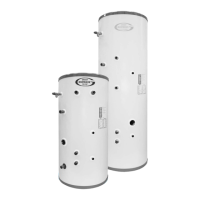Secondary Circuit
Installation
13
4.8 Tundish
The tundish must not be positioned
above or in close proximity of any
electrical current carrying devices or
wiring.
4.9 Discharge Pipe
1. The discharge pipe from the
Tundish should terminate in a safe
place where there is no risk to
persons in the vicinity of the
discharge, be of metal and:
a) Be at least one pipe size larger than
the normal outlet size of the safety
device unless its total equipment
hydraulic resistance exceeds that of
a straight pipe 9m long, i.e.
discharge pipes between 9m and
18m equivalent resistance length
should be at least larger than the
normal outlet size of the safety
device, between 18m and 27m at
least three sizes larger and so on.
Bends must be taken in to account
in calculating the flow resistance.
See Sections 4.10, 4.11 and 4.12.
b) Have a vertical section of pipe at
least 300 mm long, below the
tundish before any elbows or bends
in the pipe work.
c) Be installed with a continuous fall of
1:40 (2.5°).
d) Have discharges visible at both the
tundish and the final point of
discharge but where this is not
possible or practically difficult there
should be clear visibility at one or
other of these locations.
2. Examples of acceptance discharge
arrangements are:
a. ideally below a fixed grating and
above the water seal in a trapped
gully.
b. downward discharges at a low
level; i.e. up to 100mm above
external surfaces such as car parks,
hard standings, grassed areas etc.
are acceptable providing that where
children may play or otherwise
come in to contact with discharges,
a wire cage or similar guard is
positioned to prevent contact,
whilst maintaining visibility.
c. discharges at high level; e.g. in to
metal hopper and metal down pipe
with the end of the discharge pipe
clearly visible (tundish visible or not)
or onto a roof capable of
withstanding high temperature
discharges of water and 3m from
any plastics guttering systems that
would collect such discharges
(tundish visible).
3. Where a single pipe serves a
number of discharges, such as in
blocks of flats, the number served
should be limited to not more than
6 systems so that any installation
can be traced reasonably easily.
The single common discharge pipe
should be at least one pipe size
larger than the largest individual
discharge pipe to be connected.
If unvented hot water storage
systems are installed where
discharges from safety devices may
not be apparent i.e. in dwellings
occupied by blind, infirm or disabled
people, consideration should be
given to the installation of an
electronically operated device to
warm when discharge takes place.
Note:
The discharge will consist of
scalding water and steam. Asphalt,
roofing felt and non-metallic
rainwater goods may be damaged
by such discharges.
Balanced cold supply for showers
or bidet only (see Section 4.2)
Secondary
return line
Circulation
pump
Non return
valve
Cold inlet
Balanced cold
supply outlet
Figure 4-1: Secondary Return Circuit
Note:
If a secondary circulation circuit is installed
then a larger expansion vessel may be
required to handle the increase in volume.
4.7 Secondary Return
All DuoWave solar and HP cylinders are fitted with a secondary return connection. If a secondary return circuit is required it should be
connected to the DuoWave solar or HP cylinder as shown below:

